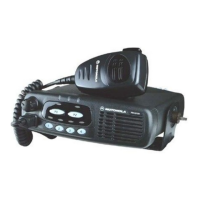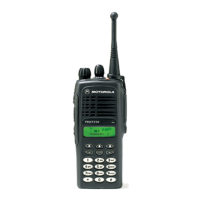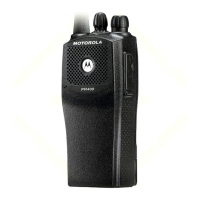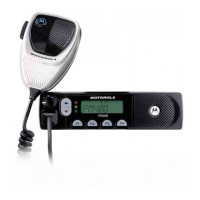Section 3: 1-14 Controller Board Audio and Signaling Circuits
Section : 6881091C63-F
2.3.1 Sub-audible Data (PL/DPL)
Sub-audible data implies signaling whose bandwidth is below 300 Hz. PL and DPL waveforms are
used for conventional operation and connect tones for trunked voice channel operation. The
trunking connect tone is simply a PL tone at a higher deviation level than PL in a conventional
system. Although it is referred to as “sub-audible data”, the actual frequency spectrum of these
waveforms may be as high as 250 Hz, which is audible to the human ear. However, the radio
receiver filters out any audio below 300 Hz, so these tones are never heard in the actual system.
Only one type of sub-audible data can be generated by U0221 (ASFIC CMP) at any one time. The
process is as follows, using the SPI BUS, the µP programs the ASFIC CMP to set up the proper low-
speed data deviation and select the PL or DPL filters. The µP then generates a square wave which
strobes the ASFIC PL / DPL encode input LSIO U0221-18 at twelve times the desired data rate. For
example, for a PL frequency of 103 Hz, the frequency of the square wave would be 1236 Hz.
This drives a tone generator inside U0221 which generates a staircase approximation to a PL sine
wave or DPL data pattern. This internal waveform is then low-pass filtered and summed with voice
or data. The resulting summed waveform then appears on U0221-40 (MOD IN), where it is sent to
the RF board as previously described for transmit audio. A trunking connect tone would be
generated in the same manner as a PL tone.
2.3.2 High Speed Data
High speed data refers to the 3600 baud data waveforms, known as Inbound Signaling Words
(ISWs) used in a trunking system for high speed communication between the central controller and
the radio. To generate an ISW, the µP first programs the ASFIC CMP (U0221) to the proper filter
and gain settings. It then begins strobing U0221-19 (HSIO) with a pulse when the data is supposed
to change states. U0221’s 5-3-2 State Encoder (which is in a 2-state mode) is then fed to the
post-limiter summer block and then the splatter filter. From that point it is routed through the
modulation attenuators and then out of the ASFIC CMP to the RF board. MDC is generated in much
the same way as trunking ISW. However, in some cases these signals may also pass through a data
pre-emphasis block in the ASFIC CMP. Also these signaling schemes are based on sending a
combination of 1200 Hz and 1800 Hz tones only. Microphone audio is muted during high speed data
signaling.
2.3.3 Dual Tone Multiple Frequency (DTMF) Data
DTMF data is a dual tone waveform used during phone interconnect operation. It is the same type of
tones which are heard when using a “Touch Tone” telephone.
There are seven frequencies, with four in the low group (697, 770, 852, 941 Hz) and three in the
high group (1209, 1336, 1477 Hz).
The high-group tone is generated by the µP (U0101-44) strobing U0221-19 at six times the tone
frequency for tones less than 1440 Hz or twice the frequency for tones greater than 1440 Hz. The
low group tone is generated by the ASFIC CMP, controlled by the µP via SPI bus. Inside U0221 the
low-group and high-group tones are summed (with the amplitude of the high group tone being
approximately 2 dB greater than that of the low group tone) and then pre-emphasized before being
routed to the summer and splatter filter. The DTMF waveform then follows the same path as was
described for high-speed data.

